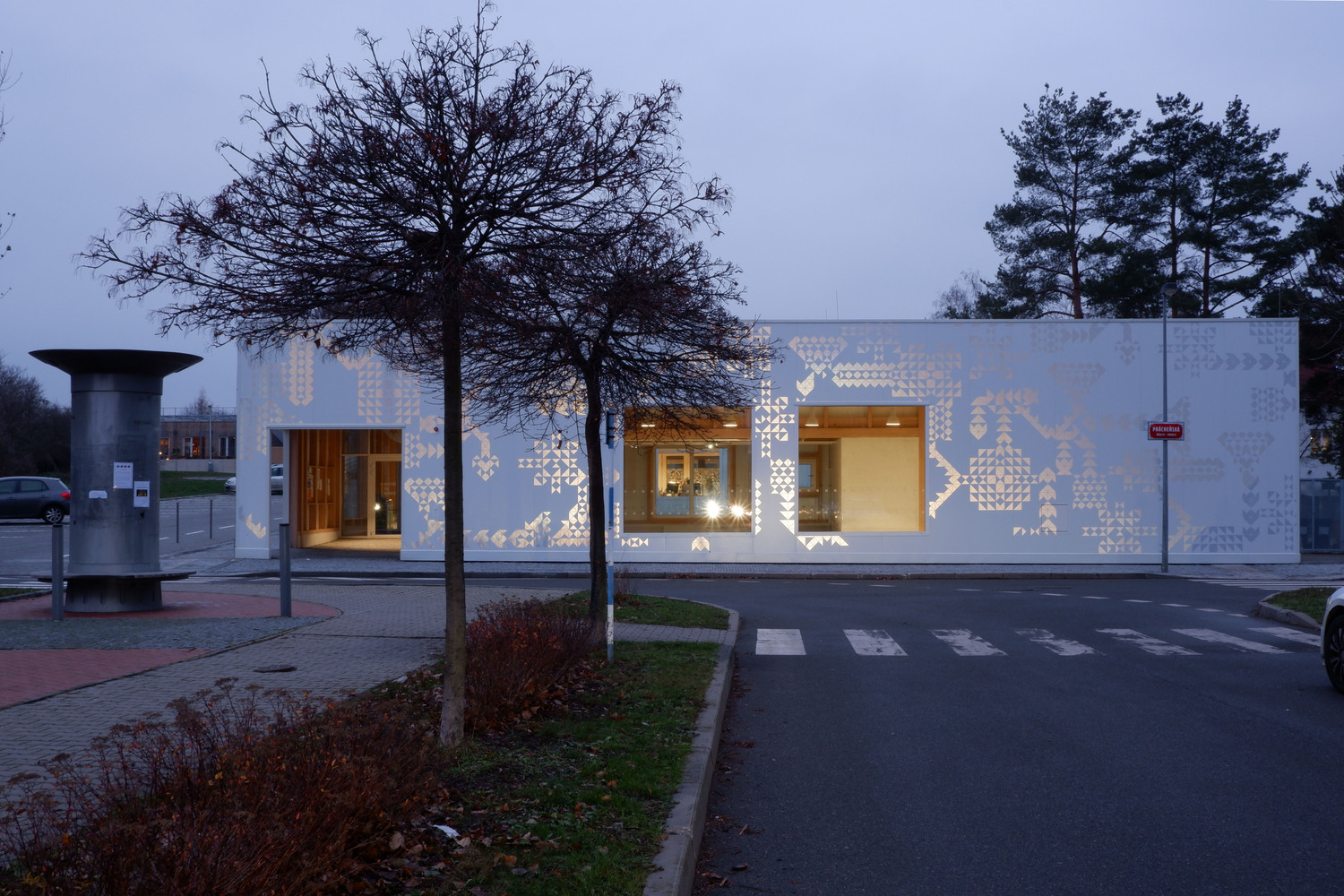Multimedia Library l’Alpha loci anima
2016-03-22 10:00
© Philippe Le Roy
菲利普·勒罗伊


架构师提供的文本描述。在越来越多地使用虚拟媒体的背景下,阿尼娜公司提供了安古尔·阿尔法媒体图书馆。阿尔法媒体图书馆建在该市东北部一个前工业区的遗址上,为胡莫区带来了额外的价值,该地区正在进行彻底的改革,改善了该地区人民的社会和文化生活。它直接靠近火车站,这意味着它很容易连接到大安古尔姆的所有社区(一座人行桥将提供直接的通道),但也能连接到整个世界。例如,阿尔法已经成为喜剧节的基石,并接待公众和各行各业的记者,这是很自然的。
Text description provided by the architects. In a context of the increasing use of virtual media, loci anima has delivered the Angoulême Alpha media library. Built on the site of a former industrial area in the north-east of the city, the Alpha media library brings added value to the Houmeau district, which is being radically overhauled, improving the social and cultural life of people in this area. Its direct proximity to the railway station means that it is easily linked to all of the communes of Greater Angoulême (in time, a footbridge will provide direct access), but also to the world as a whole. For example, it is only natural that the Alpha has become the cornerstone of the comic festival and plays host to the public and journalists from all walks of life.


在斯堪的纳维亚模式的启发下,这座建筑是新一代文化空间的具体证据,在这里,公民们能够相聚、交流、学习、放松,这些都是著名的第三地方。这种空间不分年龄,中立开放,力求消除社会文化差异,模糊公共与私人、集体与个人之间的界限。“第三位”是20世纪80年代初由城市社会学教授雷·奥尔登堡(RayOldenburg)提出的一个概念,它不同于“第一位”、“家”和“第二位”,即工作场所。
Inspired by the Scandinavian model, this building is concrete evidence of a new generation of cultural spaces where citizens are able to meet, to exchange, to learn, to relax, these famous «third places». Neutral and open to all, making no distinction in terms of age, this type of space seeks to erase socio-cultural differences and blur the boundaries between the public and the private, the collective and the individual. The “third place”, an idea developed in the early 1980s by the urban sociology professor Ray Oldenburg, is different from the “ first place’, the home, and the “second place”, the workplace.
© Philippe Le Roy
菲利普·勒罗伊


你如何创造一个对所有人开放的空间,这个空间从来没有威胁性,有强大的社会功能,每个人都可以拥有?
How do you create a space that is open to all, that is never intimidating, that has a strong societal function and that everyone can own?
在回答这个问题时,阿尼娜的创始人弗朗索瓦斯·雷诺德使用了与童年和颜色相关的词汇。然后,她设计了一座多立面的建筑,一个“景观玫瑰”,面对着安古尔的重要地标,从地球上和天空中相互面对。媒体图书馆由彩色的平行石组成,巧妙地堆放在另一个上面,从城市的高处看,构成了阿尔法和安古尔姆的A。这些组成EDI ce的“世界”中的每一个都是可扩展的,并且可以通过与它相关的天体的金属的颜色材料来识别。因此,“创造”的世界是无烟煤,指的是土星和领导。“理解”的世界让人想起月亮和银器。“想象”的世界由木星和青铜代表。太阳和黄金可以在“从一个世界到另一个世界”的世界中找到。最后,世界的“制造”是红铜,向火星致敬。
In answering this question, Françoise Raynaud, founding architect of loci anima, uses vocabulary associated with childhood and with colour. She then designs a building with multiple facades, a “rose of views”, facing the important landmarks of Angoulême and that face each other from the earth and from the sky. Made up of ve coloured parallelepipeds, cleverly stacked one on top of the other, the media library, viewed from the highpoint of the city, forms an A for Alpha and for Angoulême. Each of these ve “worlds” which make up the edi ce is scalable and identi able by the colour-material of the metal of the celestial body that is associated with it. So, the world of “creating” is anthracite in reference to Saturn and to lead. The world of “understanding” recalls the moon and silver. The world of “imagining” is represented by Jupiter and bronze. The sun and gold are to be found in the world “from one world to another”. Finally, the world “manufacture” is red copper, paying homage to Mars.
© Philippe Le Roy
菲利普·勒罗伊


儿童想象世界的内涵也体现在设计和家具上,这些家具是几何的、有趣的、实用的,回应了媒体图书馆提供的不同用途。独立办公桌周围的木制框架将读者隔离在一种氛围中,这种氛围有助于人们集中注意力,同时也为读者打开了一扇通向外部的窗户。巨大的自然点亮的桌子鼓励小组工作期间的交流。室内和室外座椅的形状都是超大的物体,例如一个安全别针或一个钉,提供的座位是有趣的,友好的和可调节的。建筑师在大厅的天花板下释放了空间,把大的东楼梯放在空中,一旦进入大楼,就创造了一个每个人都可以殖民和拥有的空间。此外,这些空间以露台或花园为外部延伸,供室内/室外居住,以充分利用各地的自然光,并根据所需或所需的热水平和光的安装情况,开放或关闭空间。
Connotations of the imaginary world of childhood are also seen in the design and the furniture which is geometrical, fun and functional, responding to the different uses that the media library offers. Wooden frames around individual desks isolate the reader in an atmosphere that lends itself to concentration that at the same time, opens a window to the outside. Massive naturally lit tables encourage exchanges during group work. Indoor and outdoor seats are in the shape of extra-large objects, for example a safety pin or a peg, providing seating that is fun, friendly and modulable. The architect has freed up the space under the ceiling in the entrance hall by placing the large East staircase in levitation, creating, as soon as one enters the building, a space that each individual can colonise and own. Additionally, the spaces are extended outside with terraces or gardens, for indoor/outdoor living, to make the most of natural light everywhere and to open up or close off the spaces depending on the heat levels and mount of light necessary or desired.
© Philippe Le Roy
菲利普·勒罗伊


基于这样的观察,城市居民越来越远离自然,在生命和自然的元素中发现一个丰富的梦想和快乐的来源,阿尼玛在这里再次创造了这座建筑作为一个生存空间。太阳、空气、植物、水和金属都是建筑工程所用的材料。除了建筑在环境方面(低能耗建筑)的真实和内在的表现之外,这种特定于轨迹动画的观察方式为项目注入了一个象征性和敏感的维度。
Based on the observation that the city dweller is increasingly cut off from nature and finds in the elements of life and nature a rich source of dreams and of pleasure, loci anima has, here again, created this building as a space for the living. Sun, air, plants, water and metal are all materials used in the construction of the project. Over and above the real and intrinsic performances of the building on environmental aspects (low energy consumption buildings), this way of seeing, which is specific to loci anima, instils a symbolic and sensitive dimension to the project.
© Philippe Le Roy
菲利普·勒罗伊
















































-500.jpg)

-pre%cc%81sentation1-500.jpg)





Architects loci anima
Location Angoulême, France
Category Library
Architect in Charge Françoise Raynaud
Project Year 2015
Photographs Philippe Le Roy































